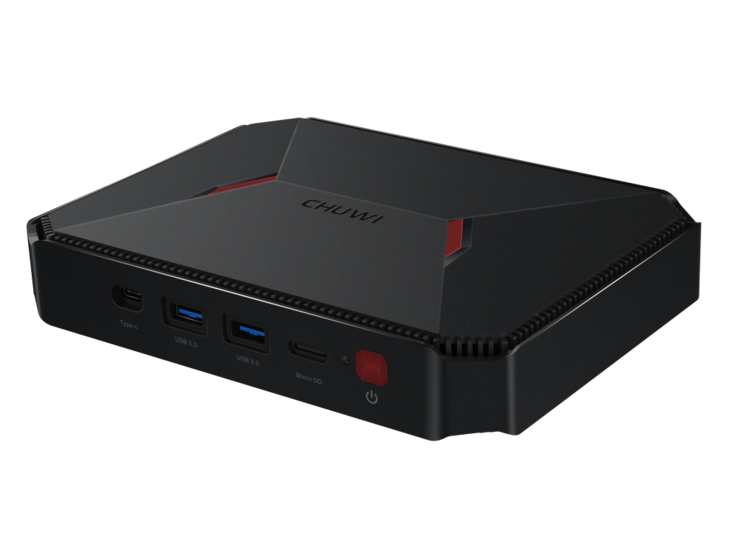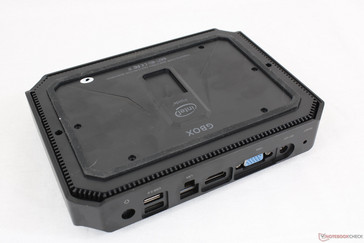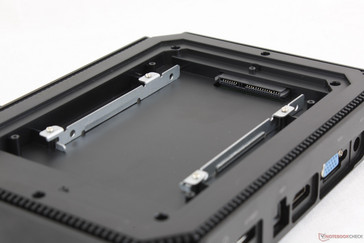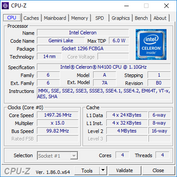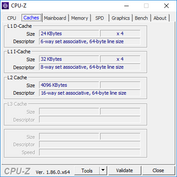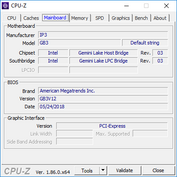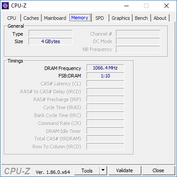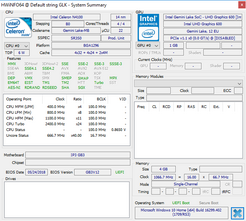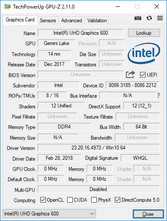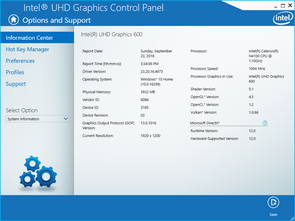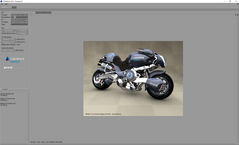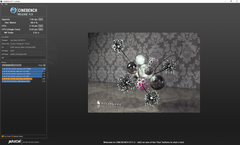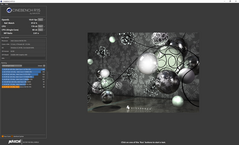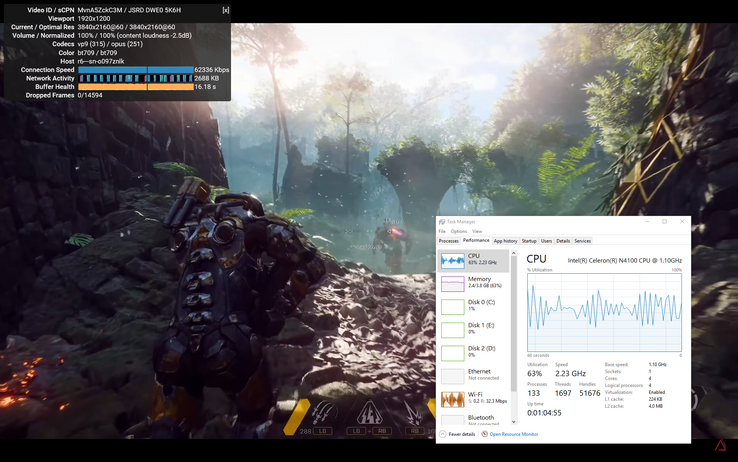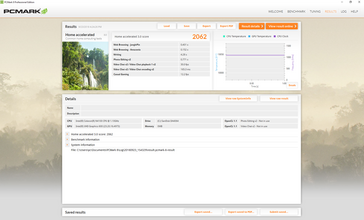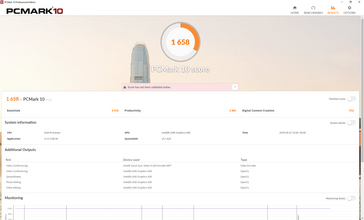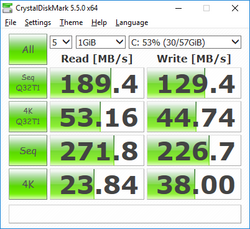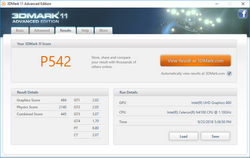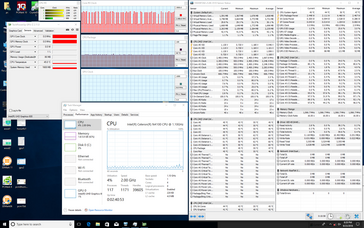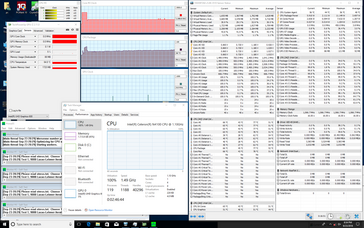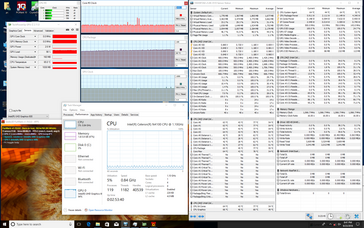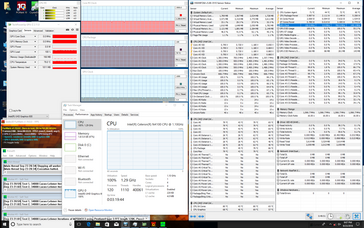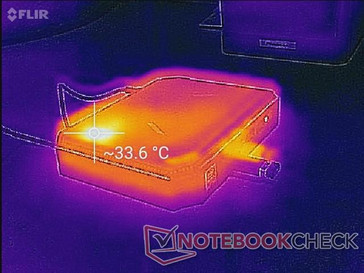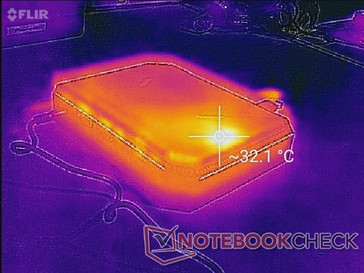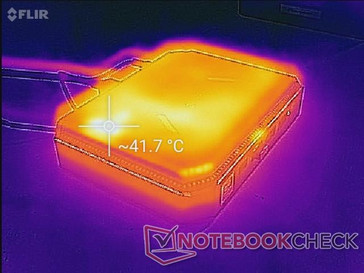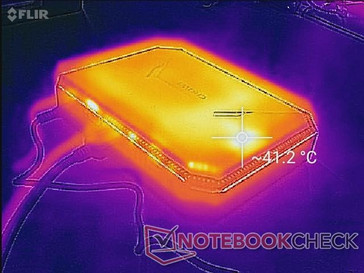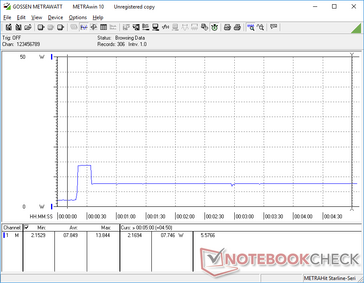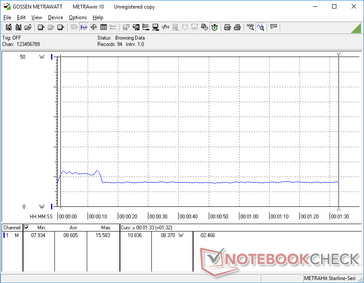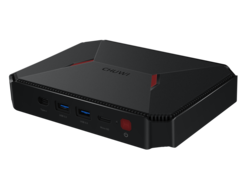Chuwi GBox CWI560 (Celeron N4100) Mini PC Review
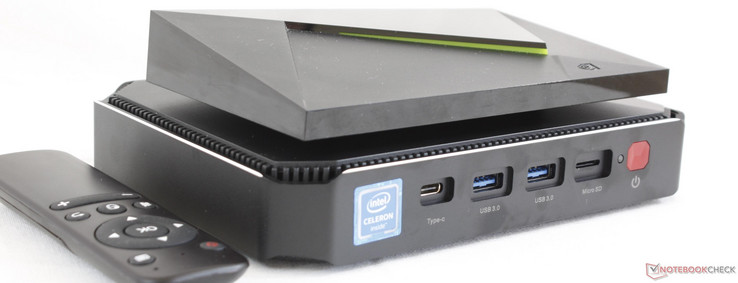
Chuwi has been making ground worldwide by offering laptops and tablets that are significantly cheaper than more popular brands while still looking sleek and attractive. The Chuwi LapBook Air notebook and Hi10 Pro tablet are the two latest examples retailing for just $380 USD and $210 USD, respectively.
The newest product to make thee list is the Chuwi GBox Windows mini PC. The system competes directly against other HTPCs including the Intel NUC, Gigabyte Brix, Zotac ZBox, and more. By extension, it also competes against streaming devices like the popular Nvidia Shield TV or Amazon Fire TV Stick.
The GBox is currently available in just one configuration at Amazon to keep costs low at just $200 USD retail. It sports a Celeron N4100 SoC with integrated UHD Graphics 600, 4 GB of LPDDR4 RAM, and a 64 GB eMMC to be comparable to alternatives like the Intel NUC BOXNUC7CJYH1 or Zotac ZBox CI329. Processor performance is of interest as Gemini Lake CPUs are relatively new and uncommon on mobile products.
More Chuwi reviews:
Case
At 0.97 L, the GBox is small as one would expect for a HTPC. Relative to other streaming boxes like the Nvidia Shield TV or more powerful Intel Skull Canyon, however, the GBox is larger in volume without necessarily being heavier for a hollow first impression not unlike the ZBox CI660. Fortunately, surfaces are rigid all around with no flexing or creaking when applying pressure. Its gamer-like design stands out from a growing crowd of boxy "me too" HTPCs from a large variety of OEMs.
A small caveat to the design is that the system has no vertical stand options. The red trims on top are simply plastic with no LEDs or other functions.
Connectivity
A healthy number of ports are available and distributed evenly across the front and back sides of the unit. The most notable are the HDMI 2.0 and VGA ports to support 4K60 output and legacy displays, respectively. The latter in particular is a rare find on newer mini PCs.
A few omissions include DisplayPort, DisplayPort over USB Type-C, Kensington Lock, IR receiver, and Thunderbolt 3 likely to save on costs. Users who wish to output to multiple displays may need a VGA to DVI adapter.
One noteworthy annoyance is that the front USB ports are upside-down while the back USB ports are right-side up. It's a minor detail that owners will surely disapprove.
SD Card Reader
Transfer rates from the spring-loaded MicroSD reader are slow at about 21 MB/s. Moving 1 GB worth of photos from our UHS-II test card to desktop takes almost 55 seconds compared to just 6 or 7 seconds on the Dell XPS 13. Speeds are sufficient for movie and music playback, but expect a long wait if transferring files.
| SD Card Reader | |
| average JPG Copy Test (av. of 3 runs) | |
| Dell XPS 13 9370 i7 UHD (Toshiba Exceria Pro UHS-II) | |
| Zotac ZBOX-CI660 Nano (Toshiba Exceria Pro SDXC 64 GB UHS-II) | |
| Chuwi GBox CWI560 (Toshiba Exceria Pro M501 UHS-II) | |
| maximum AS SSD Seq Read Test (1GB) | |
| Dell XPS 13 9370 i7 UHD (Toshiba Exceria Pro UHS-II) | |
| Zotac ZBOX-CI660 Nano (Toshiba Exceria Pro SDXC 64 GB UHS-II) | |
| Chuwi GBox CWI560 (Toshiba Exceria Pro M501 UHS-II) | |
Communication
Much like the Zotac ZBox series of mini PCs, the GBox utilizes a 1x1 Intel 3165 module for wireless speeds of up to 433 Mbps and Bluetooth 4.2. We experienced no connectivity or range issues during our time with the unit. Most Ultrabooks offer up to double the wireless speeds with faster Intel 8260 or Killer 1535 modules.
| Networking | |
| iperf3 transmit AX12 | |
| Dell XPS 13 9370 i7 UHD | |
| Chuwi GBox CWI560 | |
| Zotac ZBOX-CI660 Nano | |
| iperf3 receive AX12 | |
| Dell XPS 13 9370 i7 UHD | |
| Chuwi GBox CWI560 | |
| Zotac ZBOX-CI660 Nano | |
Accessories
Included extras are a User's Guide, warranty card, remote (2x AAA batteries not included), and an 75 mm/100 mm mounting bracket. The OEM never mentions the word "VESA" in the user guide, but we can confirm that the GBox is compatible with VESA mounts nonetheless.
The simple remote works surprisingly well with no additional setup required. Buttons have a firm click when pressed for satisfactory feedback. We only wish that its buttons could be more easily customized to perform user-defined functions. For general multimedia navigation through Windows, however, mice and keyboards still work best.
Maintenance
Removing the six Philips head screws from the bottom panel reveals an easily accessible 2.5-inch SATA III bay with support for up to 9.5 mm drives. Additional disassembly is required to access the rest of the system.
Warranty
The standard one-year manufacturer limited warranty applies. Keep in mind, however, that the buyer must pay for shipping and handling should any repairs be necessary. Please see our Guarantees, Return policies and Warranties FAQ for country-specific information.
Performance
Processor
The new Gemini Lake Celeron N4100 is roughly 22 percent and 28 percent faster than the Celeron J4005 and Celeron N4000, respectively. The performance delta is much wider when compared to the popular Cherry Trail Atom x5-Z8350 found on very inexpensive netbooks and it even marginally outperforms the Pentium Gold 4415Y in the Microsoft Surface Go. It's too bad that Chuwi doesn't offer configurations with the faster Pentium Silver N5000 for a potential 35 percent boost in performance over the N4100.
Raw processing power is still significantly slower than the common ULV 15 W Core U-series. The last generation Core i5-7200U, for example, is almost 90 percent faster than our Celeron N4100 in both single- and multi-threaded workloads. Performance over time is nonetheless consistent on the GBox as shown by our CineBench loop test results below.
See our dedicated page on the Celeron N4100 for more technical details and benchmarks.
System Performance
PCMark benchmarks are comparable to other Chuwi devices like the LapBook SE and LapBook 12.3 since they all run on low-power Celeron CPUs. Mini PCs with the more common Core i5-8250U or i7-8550U, like the ZBox CI660, are more powerful and costlier. Subjectively, the GBox is a tad slower when launching applications. The delays become noticeably longer when multi-tasking and we therefore recommend closing background applications for smoother navigation and streaming.
Interestingly, Windows Updates would fail to install on our unit. Installing the latest updates before benchmarking is common procedure for our reviews, but this was impossible due to installation errors for whatever reason.
| PCMark 10 - Score | |
| Zotac ZBOX-CI660 Nano | |
| Dell XPS 13 9370 i7 UHD | |
| Chuwi GBox CWI560 | |
| Chuwi LapBook SE | |
| Chuwi Lapbook 12.3 | |
| Intel NUC7CJYH | |
| PCMark 8 - Home Score Accelerated v2 | |
| Zotac ZBOX-CI660 Nano | |
| Dell XPS 13 9370 i7 UHD | |
| Intel NUC7CJYH | |
| Chuwi GBox CWI560 | |
| Chuwi Lapbook 12.3 | |
| PCMark 8 Home Score Accelerated v2 | 2062 points | |
| PCMark 10 Score | 1658 points | |
Help | ||
Storage Devices
The soldered SanDisk DA4064 eMMC returns SATA II-like sequential transfer rates in the mid 200 MB/s range. Inexpensive netbooks like the Lenovo Flex 6 and Teclast Tbook 16 also utilize very similar SanDisk eMMC solutions. It's a cost-saving measure that fortunately has minimal impact for streaming and low-power tasks.
See our table of SSDs and HDDs for more benchmark comparisons.
| Chuwi GBox CWI560 SanDisk DA4064 | Intel NUC7CJYH SanDisk Ultra II | Lenovo Flex 6-11IGM SanDisk DF4064 | Teclast Tbook 16 Power 64 GB eMMC Flash | Trekstor Primebook C13 SanDisk DF4064 | |
|---|---|---|---|---|---|
| CrystalDiskMark 5.2 / 6 | 121% | -30% | -81% | -36% | |
| Write 4K (MB/s) | 38 | 61.1 61% | 14.29 -62% | 1.95 -95% | 13.16 -65% |
| Read 4K (MB/s) | 23.84 | 31.99 34% | 13.12 -45% | 7.77 -67% | 5.04 -79% |
| Write Seq (MB/s) | 226.7 | 421.7 86% | 117.9 -48% | 27.89 -88% | 117 -48% |
| Read Seq (MB/s) | 271.8 | 427.4 57% | 295.7 9% | 74.7 -73% | 264.7 -3% |
| Write 4K Q32T1 (MB/s) | 44.74 | 97 117% | 13.82 -69% | 2.17 -95% | 16.58 -63% |
| Read 4K Q32T1 (MB/s) | 53.2 | 121.9 129% | 37.36 -30% | 11.62 -78% | 33.3 -37% |
| Write Seq Q32T1 (MB/s) | 129.4 | 504 289% | 105.5 -18% | 18.4 -86% | 111.2 -14% |
| Read Seq Q32T1 (MB/s) | 189.4 | 551 191% | 240.7 27% | 68.9 -64% | 226.3 19% |
| Write 4K Q8T8 (MB/s) | 183.1 | ||||
| Read 4K Q8T8 (MB/s) | 221.3 |
GPU Performance
Graphics performance from the integrated UHD Graphics 600 is unsurprisingly poor since this mini PC is not built for gaming. The UHD Graphics 620 as found on most modern Ultrabooks is significantly faster by at least 2 to 3 times. There appears to be no raw GPU performance advantages when compared to the last generation HD Graphics 500, either.
See our page on the UHD Graphics 600 for more technical information and benchmarks.
| 3DMark 11 Performance | 542 points | |
Help | ||
Stress Test
We stress the system with synthetic loads to identify for any potential throttling or stability issues. When running Prime95, the CPU can be observed operating at its maximum rated Turbo Boost of 2.3 GHz for the first few seconds before reaching a core temperature of 77 C and falling to 1.5 GHz thereafter to keep temperatures in check. When considering that the base clock rate of the Celeron N4100 is 1.1 GHz, the GBox is actually able to maintain a minor +400 MHz Turbo Boost even when under extreme CPU stress. Running both Prime95 and FurMark simultaneously will cause the core temperature to stabilize at a toasty 79 C with clock rates throttled even further.
| CPU Clock (GHz) | GPU Clock (MHz) | Average CPU Temperature (°C) | |
| System Idle | -- | -- | 45 |
| Prime95 Stress | 1.5 | -- | 66 |
| FurMark Stress | -- | 500 | 66 |
| Prime95 + FurMark Stress | 1.3 | 150 | 79 |
Emissions
System Noise
There is no noise since the GBox is a fanless mini PC for a completely silent streaming experience. Our unit exhibits no coil whine or electronic noise, either.
Temperature
Surface temperatures are warmest near the left corner of the unit at over 30 C when idling on desktop. This same spot can become as warm as 42 C during heavy loads like streaming or browsing. Results are cooler than on the more powerful ZBox CI660 Nano where temperatures can reach over 60 C. If you choose to stack DVDs or other items on top of the unit, just be aware that the they will warm up by quite a bit.
Energy Management
Power Consumption
The GBox is very power efficient consuming just 2 W to 3 W when idling on desktop compared to 9 W on the LapBook 12.3. When under extreme stress, we are able to record just under 14 W before falling and stabilizing at 7.7 W due to throttling as shown by our graph below. The results mirror our Prime95 stress test clock rates from above. Consumption is lower than even the Atom-powered Lenovo Ideapad Miix 320 since there is no display or keyboard.
The very small (~8.0 x 4.6 x 2.3 cm) 24 W AC adapter is more than sufficient for the GBox. It's a bit disappointing to not see the adapter integrated onto the unit itself for easier transporting.
| Off / Standby | |
| Idle | |
| Load |
|
Key:
min: | |
| Chuwi GBox CWI560 Celeron N4100, UHD Graphics 600, SanDisk DA4064, , x, | Chuwi Lapbook 12.3 Celeron N3450, HD Graphics 500, 64 GB eMMC Flash, IPS, 2736x1824, 12.3" | Chuwi Hi12 Z8300, HD Graphics (Cherry Trail), Hynix HCG8E 64 GB, IPS, 2160x1440, 12" | NVIDIA Shield Android TV X1, Tegra X1 Maxwell GPU, 16 GB iNAND Flash, , 1920x1080, 0" | Intel Skull Canyon NUC6i7KYK 6770HQ, Iris Pro Graphics 580, Samsung SSD 850 EVO m.2 120GB, , x, 0" | Zotac ZBOX-CI660 Nano i5-8550U, UHD Graphics 620, OCZ Vertex OCZSSD2-1VTX120G, , x, | Lenovo Flex 6-11IGM Celeron N4000, UHD Graphics 600, SanDisk DF4064, TN LED, 1366x768, 11.6" | Lenovo IdeaPad Miix 320-10ICR Pro LTE Z8350, HD Graphics 400 (Braswell), SanDisk DF4128, IPS, 1920x1200, 10.1" | |
|---|---|---|---|---|---|---|---|---|
| Power Consumption | -191% | 1% | -67% | -570% | -435% | -87% | -77% | |
| Idle Minimum * (Watt) | 1.9 | 5.9 -211% | 1.7 11% | 3.6 -89% | 14.8 -679% | 9.7 -411% | 2.7 -42% | 3 -58% |
| Idle Average * (Watt) | 2 | 7.7 -285% | 1.7 15% | 4.4 -120% | 15.7 -685% | 9.8 -390% | 4.5 -125% | 5.3 -165% |
| Idle Maximum * (Watt) | 2.9 | 8.6 -197% | 3.3 -14% | 4.6 -59% | 15.8 -445% | 11.8 -307% | 5.7 -97% | 6.4 -121% |
| Load Average * (Watt) | 8.6 | 18.2 -112% | 7.9 8% | 10 -16% | 62.7 -629% | 51.6 -500% | 13.7 -59% | 10.9 -27% |
| Load Maximum * (Watt) | 9.5 | 23.6 -148% | 10.8 -14% | 14.5 -53% | 48.5 -411% | 63.2 -565% | 20.3 -114% | 11 -16% |
* ... smaller is better
Pros
Cons
Verdict
For $200 USD, the Chuwi GBox nets you a fair amount of hardware. The system comes packed with soldered RAM, expandable storage, pre-installed Windows 10 Home, a remote, and Intel's new Gemini Lake platform for users who don't want to fiddle with barebone mini PCs. The Intel NUC, Zotac ZBox, and Gigabyte Brix series are often sold as barebone kits with higher price points once RAM, storage, and Windows are accounted for. Meanwhile, streaming devices like the Nvidia Shield lose out on the versatility of a Windows/Linux OS.
The most notable drawback of the GBox is similar to other Chuwi devices like the LapBook or Hi10 tablet. Processor performance is not as snappy as what users are accustomed to on desktops and most modern Ultrabooks. This is a machine for streaming, browsing, or word processing and not much else as any sort of light-to-moderate multi-tasking will result in skipped frames and noticeably slower loading.
Should there ever be a second-generation GBox, we'd hope for an integrated PSU with a USB Type-C charging adapter, a full-size SD reader, and a vertical orientation option.
For hassle-free home theater setups on a budget. If Android TV is unappealing, then the Chuwi GBox can get the job done as a basic Windows 10 HTPC. The low-power Celeron CPU limits multi-tasking performance to light loads only.




